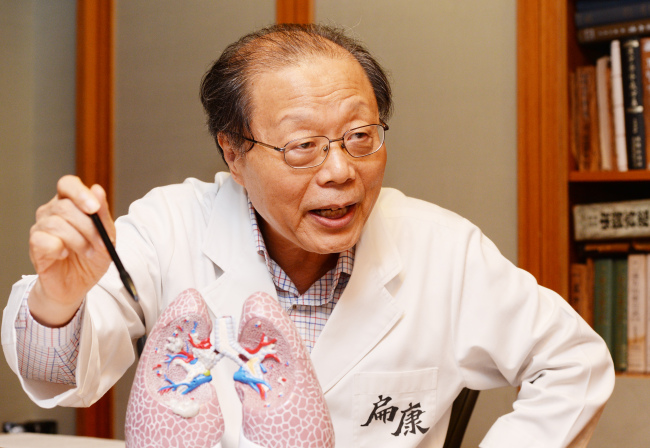How healthy lungs can bring longevity
Dr. Seo Hyo-seok shares his vision of the future of Korean traditional medicine
By Claire LeePublished : Oct. 9, 2014 - 19:39
The name of Korean traditional medicine doctor Seo Hyo-seok’s clinic, Pyunkang Korean Medicine Hospital, has a special meaning.
The word ― Pyunkang ― in fact reflects the doctor’s philosophy and vision for Korean medicine. “Pyun” means tonsils, and “kang” means wellness. Together, the words means “tonsils at ease” or “healthy tonsils.”
Seo, who has been researching lung-related diseases for the past 41 years, believes that healthy tonsils make for healthy lungs, and healthy lungs bring longevity.
The 69-year-old is currently in the U.S. for a weeklong visit to promote Korean traditional medicine, as well as his unique treatment that focuses on strengthening the lungs ― which ultimately improves chronic conditions such as asthma, atopic dermatitis and choric obstructive pulmonary disease.
“(In Korean traditional medicine) it is believed that the very basic energy which operates the human body is generated in the lungs,” the doctor said prior to his departure to the U.S. at his clinic in southern Seoul.
“The lungs are the organs that let us interact with nature and its energy, and a lot of diseases are caused by not keeping (your lungs) healthy.”
One of Seo’s best-known accomplishments is the invention of Pyunkangtang, a Korean herbal medicine made of liquid distilled from some 10 natural medicinal ingredients. The medicine is meant to strengthen the lungs and improve the body’s ability to use oxygen.
According to Seo, chronic diseases such as rhinitis, asthma and atopic dermatitis can be treated by improving one’s lung functions.
The word ― Pyunkang ― in fact reflects the doctor’s philosophy and vision for Korean medicine. “Pyun” means tonsils, and “kang” means wellness. Together, the words means “tonsils at ease” or “healthy tonsils.”
Seo, who has been researching lung-related diseases for the past 41 years, believes that healthy tonsils make for healthy lungs, and healthy lungs bring longevity.
The 69-year-old is currently in the U.S. for a weeklong visit to promote Korean traditional medicine, as well as his unique treatment that focuses on strengthening the lungs ― which ultimately improves chronic conditions such as asthma, atopic dermatitis and choric obstructive pulmonary disease.
“(In Korean traditional medicine) it is believed that the very basic energy which operates the human body is generated in the lungs,” the doctor said prior to his departure to the U.S. at his clinic in southern Seoul.
“The lungs are the organs that let us interact with nature and its energy, and a lot of diseases are caused by not keeping (your lungs) healthy.”
One of Seo’s best-known accomplishments is the invention of Pyunkangtang, a Korean herbal medicine made of liquid distilled from some 10 natural medicinal ingredients. The medicine is meant to strengthen the lungs and improve the body’s ability to use oxygen.
According to Seo, chronic diseases such as rhinitis, asthma and atopic dermatitis can be treated by improving one’s lung functions.

Seo claims that some 123,000 patients with atopic dermatitis, rhinitis or asthma have been completely cured after being treated by him, and some 32,000 individuals with lung-related diseases, including pulmonary emphysema, pulmonary fibrosis and bronchiectasis, have benefited from taking Pyunkangtang.
Pulmonary fibrosis is a respiratory disease in which scars are formed in the lung tissues, while pulmonary emphysema is a condition in which air sacs in the lungs are filled up with air, making it hard for patients to catch their breath.
Bronchiectasis, on the other hand, is a disease involving permanent enlargement of parts of the airways of the lungs. Symptoms include coughing up blood and shortness of breath.
“Those who were in the fatal stages of lung and biliary tract cancers also expanded their life span by some six months after taking Pyunkangtang,” Seo argued.
Seo’s current goal is to promote his treatment method as well as the importance of lung health to the world, so more people can benefit. Korea’s traditional medicine can be a great alternative option, especially for patients who suffer from COPD, which typically worsens over time.
“I am certain that these (chronic) conditions are not at all incurable, but in fact actually very easily curable,” he said.
On Monday, the first installment of Seo’s nine-part advertisement was published in The New York Times. He will be advertising in the American newspaper every Monday for the next eight weeks, with each installment dealing with different issues including side effects of steroids, COPD and other lung-related diseases including asthma and allergies, and how they can be cured using Korean traditional medicine.
During his ongoing visit to New York, he is scheduled to attend the U.S. East Coast Korean Thanksgiving Festival, one of the largest Korean-American festivals, to give a lecture about Korean medicine. He is also to give a special lecture on health for Chinese attendees, while providing free health consultations as well. The festival runs from Friday to Sunday.
Seo’s ultimate goal as a doctor is to increase the maximum human lifespan by 30 years, both through his treatment method and through promoting the importance of lung health worldwide.
“I am thinking of this as the beginning of a 10-year project,” Seo said about the New York Times advertisement.
“Some may think this is a rather reckless try, but if someone in the U.S. who suffers from a lung-related disease sees the ad and gets his or her healthy life back, nothing can be more rewarding. I am trying to let more people around the world (who have this particular chronic illness) know that there is hope.”
By Claire Lee (dyc@heraldcorp.com)







![[KH Explains] Hyundai's full hybrid edge to pay off amid slow transition to pure EVs](http://res.heraldm.com/phpwas/restmb_idxmake.php?idx=644&simg=/content/image/2024/04/18/20240418050645_0.jpg&u=20240419100350)






![[From the Scene] Monks, Buddhists hail return of remains of Buddhas](http://res.heraldm.com/phpwas/restmb_idxmake.php?idx=652&simg=/content/image/2024/04/19/20240419050617_0.jpg&u=20240419175937)

![[KH Explains] Hyundai's full hybrid edge to pay off amid slow transition to pure EVs](http://res.heraldm.com/phpwas/restmb_idxmake.php?idx=652&simg=/content/image/2024/04/18/20240418050645_0.jpg&u=20240419100350)

![[Today’s K-pop] Illit drops debut single remix](http://res.heraldm.com/phpwas/restmb_idxmake.php?idx=642&simg=/content/image/2024/04/19/20240419050612_0.jpg&u=)